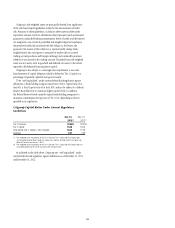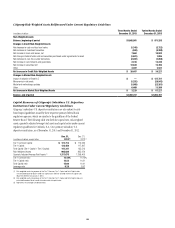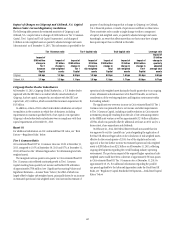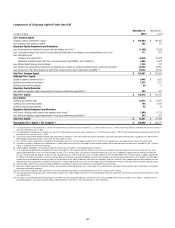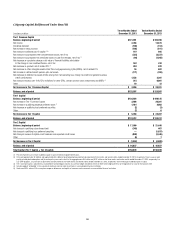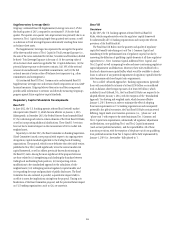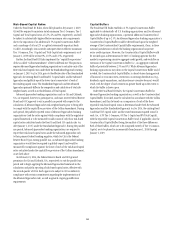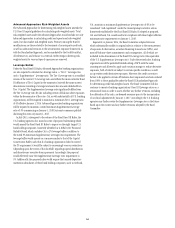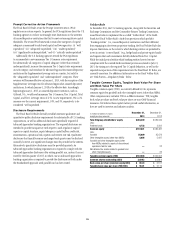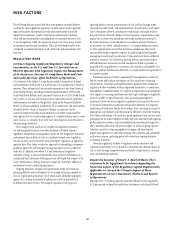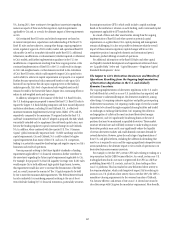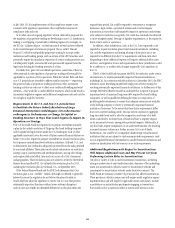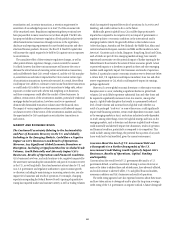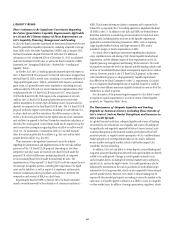Citibank 2013 Annual Report Download - page 70
Download and view the complete annual report
Please find page 70 of the 2013 Citibank annual report below. You can navigate through the pages in the report by either clicking on the pages listed below, or by using the keyword search tool below to find specific information within the annual report.52
Risk-Based Capital Ratios
Under the Final Basel III Rules, when fully phased in by January 1, 2019,
Citi will be required to maintain stated minimum Tier 1 Common, Tier 1
Capital and Total Capital ratios of 4.5%, 6% and 8%, respectively, and will
be subject to substantially higher effective minimum ratio requirements
due to the imposition of an additional 2.5% Capital Conservation Buffer
and a surcharge of at least 2% as a global systemically important bank
(G-SIB). Accordingly, Citi currently anticipates that its effective minimum
Tier 1 Common, Tier 1 Capital and Total Capital ratio requirements as of
January 1, 2019 will be at least 9%, 10.5% and 12.5%, respectively.
Further, the Final Basel III Rules implement the “capital floor provision”
of the so-called “Collins Amendment” of the Dodd-Frank Act. This provision
requires Advanced Approaches banking organizations to calculate each of the
three risk-based capital ratios under both the Standardized Approach starting
on January 1, 2015 (or, for 2014, prior to the effective date of the Standardized
Approach, the existing Basel I and Basel II.5 capital rules) and the Advanced
Approaches and publicly report the lower (most conservative) of each of
the resulting capital ratios. The Standardized Approach and the Advanced
Approaches primarily differ in the composition and calculation of total risk-
weighted assets, as well as in the definition of Total Capital.
Advanced Approaches banking organizations such as Citi and Citibank,
N.A. are required, however, to participate in, and must receive Federal Reserve
Board and OCC approval to exit a parallel run period with respect to the
calculation of Advanced Approaches risk-weighted assets prior to being able
to comply with the capital floor provision of the Collins Amendment. During
such period, the publicly reported ratios of Advanced Approaches banking
organizations (and the ratios against which compliance with the regulatory
capital framework is to be measured) would consist of only those risk-based
capital ratios calculated under the Basel I and Basel II.5 capital rules (or,
after January 1, 2015, under the Standardized Approach). During the parallel
run period, Advanced Approaches banking organizations are required to
report their risk-based capital ratios under the Advanced Approaches only
to their primary federal banking regulator, which for Citi is the Federal
Reserve Board. Upon exiting parallel run, an Advanced Approaches banking
organization would then be required to publicly report (and would be
measured for compliance against) the lower of each of the risk-based capital
ratios calculated under the capital floor provision of the Collins Amendment,
as set forth above.
On February 21, 2014, the Federal Reserve Board and OCC granted
permission for Citi and Citibank, N.A., respectively, to exit the parallel run
period and to begin applying the Advanced Approaches framework in the
calculation and public reporting of risk-based capital ratios, effective with
the second quarter of 2014. Such approval is subject to Citi’s satisfactory
compliance with certain commitments regarding the implementation of
the Advanced Approaches rule, as well as general ongoing qualification
requirements.
Capital Buffers
The Final Basel III Rules establish a 2.5% Capital Conservation Buffer
applicable to substantially all U.S. banking organizations and, for Advanced
Approaches banking organizations, a potential additional Countercyclical
Capital Buffer of up to 2.5%. An Advanced Approaches banking organization’s
Countercyclical Capital Buffer would be derived based upon the weighted
average of the Countercyclical Capital Buffer requirements, if any, in those
national jurisdictions in which the banking organization has private
sector credit exposures. Moreover, the Countercyclical Capital Buffer would
be invoked upon a determination by the U.S. banking agencies that the
market is experiencing excessive aggregate credit growth, and would be an
extension of the Capital Conservation Buffer (i.e., an aggregate combined
buffer of potentially between 2.5% and 5%). While Advanced Approaches
banking organizations may draw on the Capital Conservation Buffer and, if
invoked, the Countercyclical Capital Buffer, to absorb losses during periods
of financial or economic stress, restrictions on earnings distributions (e.g.,
dividends, equity repurchases, and discretionary executive bonuses) would
result, with the degree of such restrictions greater based upon the extent to
which the buffer is drawn upon.
Under the Final Basel III Rules, the Capital Conservation Buffer for
Advanced Approaches banking organizations, as well as the Countercyclical
Capital Buffer, if invoked, must be calculated in accordance with the Collins
Amendment, and thus be based on a comparison of each of the three
reportable risk-based capital ratios as determined under both the Advanced
Approaches and the Standardized Approach (or, for 2014, the existing Basel
I and Basel II.5 capital rules) and the stated minimum required ratios for
each (i.e., 4.5% Tier 1 Common, 6% Tier 1 Capital and 8% Total Capital),
with the reportable Capital Conservation Buffer (and, if applicable, also the
Countercyclical Capital Buffer) being the smallest of the three differences.
Both of these buffers, which are to be comprised entirely of Tier 1 Common
Capital, are to be phased in incrementally from January 1, 2016 through
January 1, 2019.



